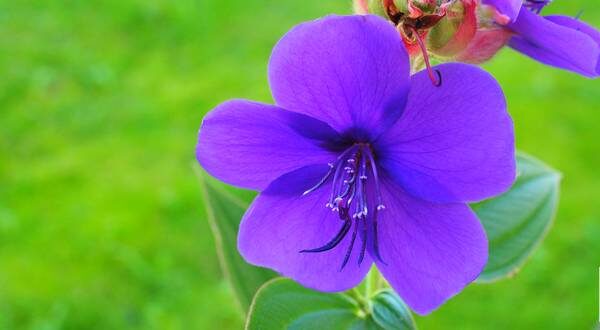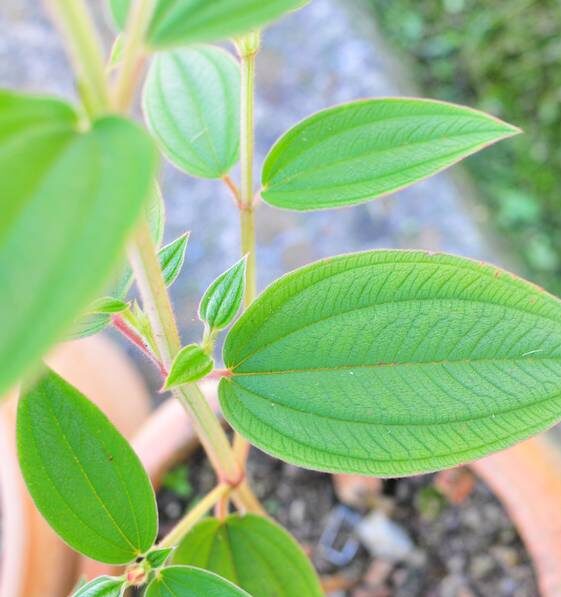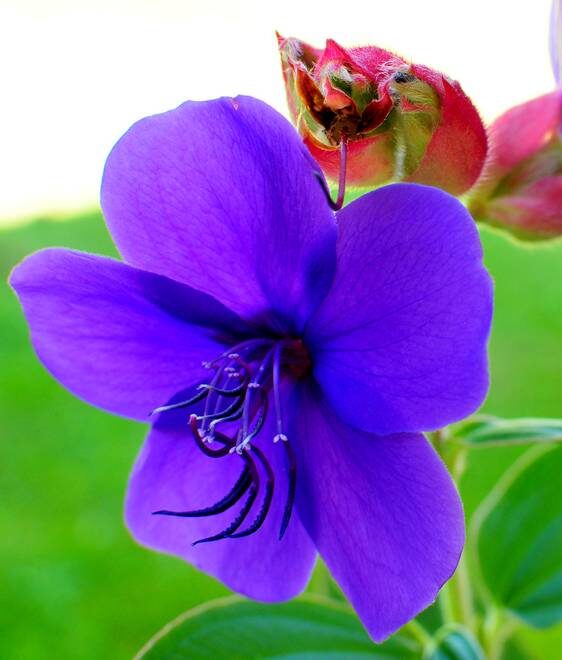
Originally from the tropical regions of Brazil, the Tibouchina genus belongs to the Melastomataceae family, which includes more than 300 species of trees, shrubs and climbing plants, all perennials but to be reserved for regions with mild climates, taking into account of their origin.
In USA, only one species is generally grown, rather in pots: it is Tibouchina urvilleana , also called Tibouchina semidecandra .
Quadrangular stems, velvety leaves
Tibouchina urvilleana forms over the years a shrub with square stems, rigid but brittle, covered with a fine down. Reddish in color, the shoots of the year evolve to gray to brown hues as they become lignified. The originality of the silhouette of the Tibouchina is based on a particularity: the departures of new shoots are concentrated on the nodes somewhat reminiscent of the angular and graphic habit of a tall perennial plant that is also South American: the verbena of Buenos Aires.
The evergreen leaves of Tibouchina urvilleana , simple and velvety, have 5 very marked longitudinal veins. In a superb emerald green, surrounded by a discreet red border, they have a more gray appearance on the reverse. Oval in shape and about 10 cm long, they end in a soft point. They take on a beautiful coppery color in the fall.

The very elegant red flower buds are gathered in clusters at the ends of the shoots. When they open, the large, brightly colored flowers (5 to 8 cm in diameter) unfurl to reveal 5 satiny violet petals, delicately veined. The center of the flower is enhanced with purple stamens comparable to spider legs; they are at the origin of the nickname ” spider flower ” sometimes attributed to this beautiful exotic plant introduced in Europe during the 19th century.
Flowering is spread over several months. It starts towards the end of summer and continues without interruption until the first frosts, sometimes even more when Tibouchina urvilleana is moved to a sheltered situation. In mild regions, the shrub is even slightly ascending, offering a more timid flowering during spring (April)
Where to grow this chilly plant?
Moderately hardy (0 to -2°C), the tibouchine requires a very bright, warm exposure, protected from drafts, but sheltered from excessively scorching sun. In hot regions, install it in partial shade
In cold regions, as this shrub does not tolerate very high negative temperatures, it is better to grow it in a pot to have the chance to see it bloom but also to be able to easily overwinter it in the company of other frost-resistant plants from the month of October. However, it spends the whole summer outside in the company of certain indoor plants.
In mild climates, along the Mediterranean rim, and in some protected resorts on the Basque or Breton coast, it can be planted under the shelter of a wall, for example. The shrub can then rise to more than three meters in height and remains in bloom for many months.
On the soil side, the spider flower appreciates a rich, well-drained, slightly acidic soil.
For a pot culture, place a layer of gravel on the bottom. Then prepare a mixture of equal parts of garden soil, potting soil and heather soil.

Tibouchina watering
Regular watering is essential: the growing medium for Tibouchina urvilleana must never completely dry out throughout the growth and flowering phase of the plant, from spring to late autumn; otherwise the flowers do not open and the leaves redden entirely before falling.
But also avoid excess water. Remember in particular to empty the saucers a few minutes after abundant watering. During the bad season, reduce them: a supply of water every 15 days is enough for tibouchines grown in pots .
Sheltered from the wind!
Protect the tibouchine from the winds : not only do they lower the already average hardiness of the plant, but they also cause a lot of damage among the brittle and generally frail stems of this beautiful exotic plant. In a windy situation, the petals of the flowers fall too quickly!
When to prune the tibouchine?
Pruning is done after flowering, at the end of autumn (November or December). Remove dead wood, balance the silhouette.

Fertilizer inputs
2 to 3 inputs of fertilizer for Mediterranean plants per year help support the growth and generous flowering of the tibouchine . Prefer a slow-release organic fertilizer, mixed with the soil, rather than a liquid fertilizer diluted in the irrigation water.
The first application is made at the end of winter, when vegetation resumes, the second during the summer and the last when flowering approaches, at the end of summer/beginning of autumn.
How to multiply it?
Tibouchina urvilleana is propagated by cutting the shoots of the year, a gesture to be made at the beginning of spring or at the end of summer. Prick the prepared cuttings into a mixture of fine potting soil and moistened sand.
Remarkable varieties of Tibouchina
The Melastomataceae group living plants in the same tropical climate. Only one genus is generally sold in USA: the Medinilla, a houseplant with very long pink hanging clusters.
Among the tibouchines, apart from the type-species, the varieties are rare! Here is one:
Groovy Baby: very compact. It forms over the years a flowery cushion.
